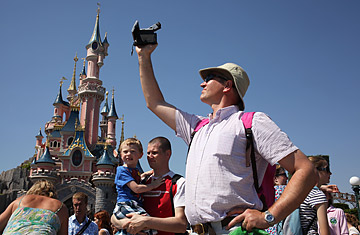
Castle in the sky Disney overestimated visitors and their spending
(2 of 3)
Losing the Sparkle
Disneyland Paris was Disney's second theme-park venture abroad, after the one in Tokyo, which opened nine years earlier. (A third opened in Hong Kong in 2005.) It helped set the parameters of Disney's involvement. In Japan the company, wary of the risks, focused on earning licensing fees and allowed a Japanese company, Oriental Land, to take ownership of the resort. Tokyo quickly proved a big financial and commercial success, and the arrangement meant Disney didn't get as much of the upside as the owner did. In Paris, Disney was determined not to make the same mistake.
The intricate public-private partnership it negotiated with the French state was finalized in 1987. The deal gave Disney a big ownership stake, along with control of more than 2,000 hectares of land — and some ironclad government commitments to finance important infrastructure, including roads and a high-speed rail line. For the first park, which has a classic Sleeping Beauty castle, Disney spared no expense. The attention to detail is still evident in the elaborate decoration of the stores and restaurants along Main Street, USA, and in the rich landscaping. "It's probably the most beautiful castle park Disney has built so far," says Adam Bezark, an industry creative consultant involved in early discussions for the Discoveryland section. "Lots of love was put into every corner of it and not just the attractions."
A decade later, a second park, Walt Disney Studios, opened in the resort, and it reflected the drearier economy. The studio park seems lovelorn by comparison, with minimal landscaping. To get to the castle, visitors stroll through charming lanes; to access the studios, they trudge through a dark, restaurant-lined passageway that reeks of fried food.
Whatever their differences, both parks had the same problem: they were built using over-ambitious projections of visitors, including the number of overnight stays in Disney hotels, which languished because many visitors arrived on day trips from Paris. "We built something that was too big for what the market could absorb," acknowledges the French company's chief financial officer, Mark Stead. The first park initially attracted 9 million visitors, rather than the 11 million expected, and hotel occupancy just breached 50%. When recession hit in 1992, some of the hotels were so under-occupied, they shut down for the winter. The company reached an agreement in 1994 with its lenders to restructure its finances and then had to go to them a second time in 2004, after lofty expectations about the second park's performance bumped into the harsh reality of a European recession. "History repeated itself," Stead says.
The Walt Disney Co. came out of these restructurings the worse for wear, having to waive or defer its royalties and management fees, invest in new rights issues that bumped up its ownership stake in Euro Disney and extend lines of credit or new investment. Business picked up in the mid-2000s, helped by a 15th-anniversary celebration in 2007 and a new ride, the Twilight Zone Tower of Terror, but that upturn came to a halt with the financial crisis, which hurt parks not only in France but worldwide.
Disney hopes this 20th anniversary will prove to be another "booster year," as Stead puts it, but so far, the results have been mixed. In the quarter that ended June 30, the anniversary high season, average spending at the park rose 3%, giving Euro Disney stock a boost, but hotel occupancy dropped. Certainly, European consumers are more skittish than ever and are looking for last-minute deals. Geography hasn't helped. Federico Gonzalez, head of marketing for Euro Disney, says that for people arriving from other European countries like Spain or the U.K., travel can account for up to half the price of a trip to Disneyland. And when times get tougher, that cost can be prohibitive: from 2009 to 2010, Disney cut its ticket prices by as much as 40% for British visitors, but their attendance still dropped.
In Tokyo and Hong Kong, Disneyland visitors are mainly local, whereas Disneyland Paris has to draw customers from across Europe. So the company has been working with airlines and tour operators to provide attractive packages, including offers that allow children under 12 to travel free. "The overall cost remains important, but what people are really looking for is a good deal," Gonzalez says.
The company won't give details, but the Internet is full of chatter that a new attraction — based on the hit Pixar movie Ratatouille, about a rat turned gourmet chef — is on its way to help boost traffic. Marketing and new attractions can do only so much, however. Barring a Disney buyout, the main solution to Euro Disney's financial crunch is the hard-slog one: tight financial controls and careful investing to nudge up cash generation, coupled with a strategy to reduce that debt. The company has paid down about $500 million over the past five years, and management hopes to pay down as much again over the next six years. "In the past we had the attitude 'Let's build it, and people will come.' Now we say 'Let them come and figure out why they come, and then let's build,'" Stead says.
